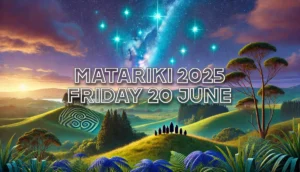Māori Lunar Calendar
The Māori Lunar Calendar: Exploring the Connection to Matariki
Matariki, the Māori New Year, is celebrated in New Zealand during the rise of the Matariki star cluster. Matariki is deeply rooted in Māori culture and tradition, and is an important time for reflection, planning and new beginnings. The Māori lunar calendar, which was used prior to the arrival of Europeans in New Zealand, plays a significant role in the timing of Matariki celebrations. In this article, we will explore the connection between the Māori lunar calendar and the celebration of Matariki.
What is the Māori Lunar Calendar?
The Māori lunar calendar, also known as the Maramataka, is based on the cycles of the moon. It is a complex system that divides the lunar month into 30 phases, with each phase representing a specific type of weather and natural event. These phases are used to guide daily activities such as planting, harvesting, fishing and hunting. The Maramataka was used extensively by Māori before the introduction of the Gregorian calendar in the late 18th century.
Connection between the Māori Lunar Calendar and Matariki
The timing of Matariki celebrations is closely linked to the Māori lunar calendar. The rise of Matariki signals the start of the Māori New Year, which begins on the day of the new moon following the rising of the Matariki cluster. This usually occurs in late May or early June in New Zealand. The Māori lunar calendar is used to determine the exact timing of Matariki celebrations, as the date of the new moon can vary from year to year.
In addition to marking the start of the Māori New Year, the Maramataka also plays a role in determining the appropriate time for planting and harvesting. For example, the appearance of the full moon in the month of Pipiri (June/July) signals the time to plant kumara (sweet potato). The full moon in the month of Mahuru (April/May) marks the end of the harvesting season.
Traditional Matariki Celebrations Based on the Māori Lunar Calendar
Traditional Matariki celebrations are deeply rooted in Māori culture and the Māori lunar calendar. During the Māori New Year, families come together to reflect on the past, acknowledge achievements and plan for the future. Some of the traditional Matariki celebrations include:
- Whakapapa (genealogy) – This is a time to acknowledge and remember ancestors, and to learn about family history and traditions.
- Kōrero (storytelling) – Stories are shared to pass on knowledge, wisdom and values to younger generations.
- Waiata (songs) – Songs are sung to express emotions and to celebrate the beauty of Matariki.
- Hākari (feasts) – A feast is prepared and shared, featuring traditional Māori foods such as kai moana (seafood), kai rēhia (delicacies) and kai kōrero (foods to share stories around).
- Haka (dance) – Haka is performed to acknowledge and respect ancestors, and to celebrate the coming of the New Year.
Modern Celebrations
In modern times, Matariki celebrations have been revived and are becoming increasingly popular in New Zealand. Many communities and organizations now hold events and festivals to celebrate Matariki, and the Māori lunar calendar is still used to determine the timing of these celebrations.
Māori Lunar Calendar
The Māori lunar calendar plays an important role in the celebration of Matariki, the Māori New Year. The timing of Matariki celebrations is closely linked to the cycles of the moon, and traditional celebrations are deeply rooted in Māori culture.


